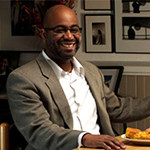
This post was updated on June 20, 2023
To millions of African-Americans, macaroni and cheese is soul food—many even believe a soul food cook invented the dish a long, long time ago in a kitchen far, far away. This is surprising, given its clear Italian origins and current status as a universal comfort food. And African-Americans, and others who trace their genetic heritage to West Africa, don’t eat much dairy (these communities tend to have a higher incidence of lactose intolerance). So how did mac and cheese end up on the soul food plate? The answer lies in the food’s longtime prestige in Europe and later in the antebellum American South.
Macaroni and cheese debuted in regal cuisine. The earliest recorded recipe—a simple combination of boiled pasta, butter, and parmesan cheese—appeared in the circa-1390 Forme of Cury cookbook, the go-to resource for cooks in royal kitchens across Europe. Over time, mac methods evolved to include eggs, milk, different cheeses, bread crumbs, and more, eventually becoming the goopy excess we know and love today.
Macaroni and cheese trickled down from palaces to Europe’s aristocratic homes, where the dish was enjoyed well into the eighteenth century. Wealthy Americans who traveled across the pond fell in love at first bite and, eager to mimic the Continental lifestyle, started serving mac and cheese on their own tables when they returned home. The poster child for this foreign food love affair was undoubtedly Thomas Jefferson, who first ate macaroni and cheese during a diplomatic stint in France in the late 1780s. He was so smitten by the delicacy that he smuggled a macaroni maker back to the United States so he could prepare it for dinner parties. As president, Jefferson served macaroni and cheese in the White House on February 6, 1802. One of the guests that night, U.S. Rep. the Rev. Manasseh Cutler of Massachusetts, was less than impressed, writing about the “strong” and “not very agreeable” taste of the new food in his diary.
Unlike Cutler, many wealthy Southerners embraced macaroni and cheese, frequently including it on menus to mark special occasions. The recipe, variously titled “macaroni,” “macaroni pie,” or “macaroni pudding,” shows up in many pre–Civil War Southern cookbooks, from privately printed family volumes to higher-profile tomes such as The Virginia Housewife (1824), The Kentucky Housewife (1839), and The Carolina Housewife (1847).
When macaroni and cheese was served at a plantation’s Big House, or mansion, it was often enslaved African-Americans who did the cooking. There aren’t many historic references to the dish being prepared in slave cabins, however, probably because the ingredients were rare and expensive. In some documented cases plantation slave owners would distribute cheddar wedges on Christmas Day and the Fourth of July, but that was also rare.
After Emancipation, macaroni and cheese took on new life and multiple identities within the Black community: It became a celebratory dish, a convenient comfort food, and a meal stretcher for impoverished families. In the latter scenario, poor households relied on the government (antihunger programs and the School Lunch Program) and relief organizations for food—they often received macaroni and processed cheese, the makings of a quick meal.
Once African-American families prospered, however, home cooks served up the kind of macaroni and cheese seen on other middle-class family tables: macaroni made from scratch with a roux or supermarket convenience products (boxes, microwave tubs, frozen meals). However, the most glorious version was reserved for Sunday dinner, when company came over. Prepared more like a casserole, the dish contained eggs, extra cheese and milk, maybe even some meat and vegetables, all with a bread crumb topping. Soul food restaurant patrons have come to expect this fancy version—though they’d be just as happy with a simpler yet still soul-nourishing recipe.
Mac and Cheese
Ingredients
- 1 pound elbow macaroni
- 3 ½ tablespoons unsalted butter divided, plus 2 tablespoons melted unsalted butter
- 1 yellow onion sliced
- 3 tablespoons all-purpose flour
- 2 ¼ cups warmed whole milk plus more as needed
- 1 teaspoon salt
- ⅛ teaspoon ground white pepper
- Pinch freshly grated nutmeg
- 3 ½ cups grated Cantal Gruyère, or sharp cheddar cheese, divided (about 1 pound)
- 2 tablespoons chopped fresh parsley
- 1 tablespoon finely chopped fresh rosemary
- 1 tablespoon chopped fresh thyme
- 2 cups bread crumbs
Instructions
- Heat oven to 350°F. Grease a 2½-quart casserole dish.
- Cook macaroni according to package directions. Drain and set aside.
- Melt 1 tablespoon butter in a medium skillet over medium-high heat. Add onion and cook, stirring often, until very soft and golden brown, about 12 minutes. Set aside.
- Melt remaining 2½ tablespoons butter in a large saucepan over medium heat. Add flour and cook, stirring constantly, until mixture is pale yellow and frothy, about 2 minutes. Do not allow it to brown.
- Slowly whisk in milk, continuing to whisk until roux boils and thickens enough to coat the back of
- a spoon, 2 to 3 minutes. Season with salt, pepper, and nutmeg.
- Reduce heat to low, add 3 cups of cheese, and stir until cheese melts. The sauce should be the consistency of pancake batter, so thin with milk if necessary.
- Stir in macaroni, onions, parsley, rosemary, and thyme, and pour mixture into the greased dish. Sprinkle remaining ½ cup cheese over the top.
- In a small bowl, toss bread crumbs with 2 tablespoons melted butter and sprinkle over the casserole.
- Bake until casserole is warmed through and the top is lightly browned, about 30 minutes. Let sit for 10 minutes and serve warm.
Feature Photo Credit: farbled | Shutterstock




